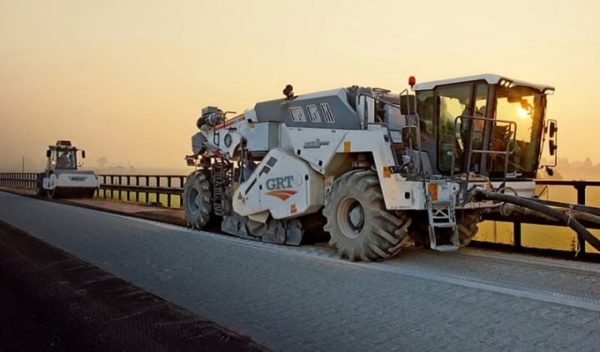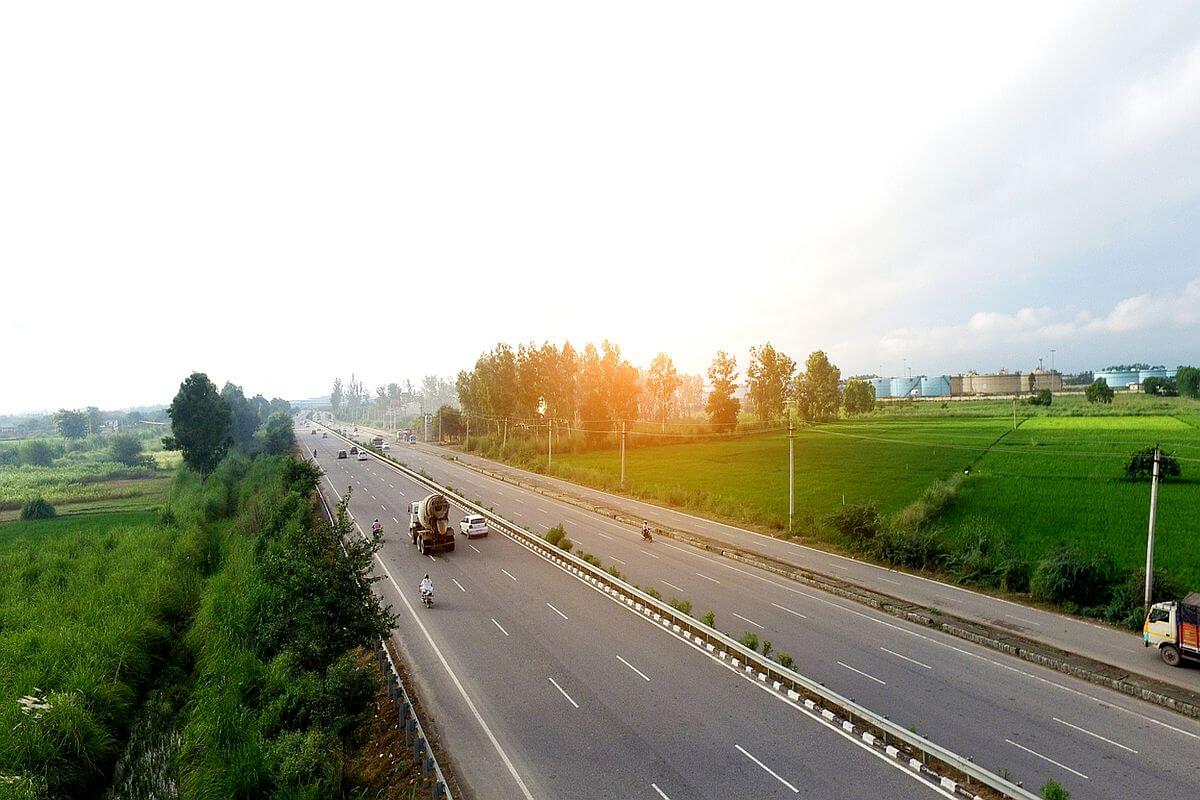Roads and Highways Route to Prosperity – State agencies are seeking quality construction of roads, which necessitate the use of the latest technology.
By:
Jayashree
Mendes
Journalist for
Construction
Week February
2017
Over
the last two
years, India
has been
building roads
and highways at
breakneck
speed. This is
a far cry from
the days in
2013-14 when
the rate of
construction
was a mere
15.7km/day.
Today,
going by
official
figure,
construction of
highways is a
little more
than 20km/day
and, if all
goes well, it
is likely to
escalate to
30-35km/day by
the end of this
year. Though
the
government’s
target to
hasten the pace
of construction
of highways to
30km/day is
still o be
achieved, it
has indeed
managed to add
pace to the
process.
If
India is to
build her
infrastructure
in terms of
roads &
highways (among
other things),
she will need
to invest $1.7
trillion on
projects before
2020 to meet
economic needs.
For the most
part, this will
go into
upgrading the
current roads
and highways
network. What
will play a
critical role
here is the
adoption of
technology,
which has seen
an aberration
so far.
In India, we have other challenges in the way we work here with respect to the actual deployment of technology and equipment. It is, therefore, not only necessary to have the equipment and technology available, but it would help if this is mandated by the government agencies or authorities, who in turn have to be convinced that the newer equipment results in building better roads. They will be more durable against the vagaries of nature or excessive traffic abuse if advanced equipment is used. The quality and monitoring standards of the project agency should necessitate the use of latest technology – and the technology owners need to themselves convince the agency of the relevance of their new products.
According to industry persons, this is already happening. Project agencies have become vigilant and are increasingly monitoring the construction process and the quality of roads. The process to monitor even in the smaller roads under the Pradhan Mantri Gram Sadak Yojana (PMGSY) shows that the state agencies are alert to the quality of the final output. As they become more strict and demanding, the newer and more effective technology will become adaptable. While there is a natural progression in technology, it needs to be pushed by all interested parties.

THE ROAD TO RENEWAL
However,
there are
several people
in the industry
who have
misgivings
about the
pro-activeness
of the Union
Ministry and
their
assertiveness
across the
state. Ben W
James , founder
& CEO, GRT,
says, The
NHAI has
approved the
use of our CIPR
technologies,
yet state
governments are
hesitant to go
along. Better
direction and
adherence to
recent
government
circulars needs
to be adopted
to break
through the
archaic
adoption of
bygone era
construction
techniques and
technology.”
Obviously, the
current
economic
ecosystem of
existing
contractors
needs to be
taken into
consideration
as most of them
are not in a
position to
invest in new
equipment –
and while there
is no need to
take an
alarmist
position –
they must
understand that
new technology
will create
opportunity,
not dissolve
it.
Ben W
James,
GRT
With
the Central
government’s
focus on
infrastructure
development,
there is a huge
demand for
improved
infrastructure
at airports,
railways,
roads,
sanitation
facilities,
urban and rural
housing, office
spaces and
numerous other
projects across
the country.
This also
indicates the
demand and
growth of the
construction
equipment
industry in
India “NHAI
has approved
the use of our
CIPR
Technologies,
yet state
governments are
hesitant to go
along
Shalabh
Chaturvedi,
head of
marketing, CASE
India, says,
The
government has
introduced
methodological
processes that
have outlined a
positive intent
for the
industry. With
the new
investment-friendly
policies, there
will be an
increase in PPP
and investments
within the
sector.
However, due to
lack of
innovative
funding models
and uncertain
business
environment,
this sector is
yet to develop
completely.
The
collaboration
between
industry bodies
and the
government can
help India’s
infrastructure
and allied
industries
achieve its
full potential
by implementing
an array of
proactive
initiatives
such as need to
streamline land
acquisition and
clearance
delays,
improved
funding for
infrastructure
projects,
adoption of
innovative
operating and
business
models, among
other things.
Better
awareness of
the benefits of
using qualified
manpower,
training
programs and
scholarships
for manpower
training can be
a boon for the
industry. Also
the buyback
plans and used
equipment
exchanges can
help strengthen
the market for
the sale of
used machinery.
With the new
investment-friendly
policies, there
will be an
increase in PPP
within the
sector
Shalabh
Chaturvedi,
Case
India.
Relevant
technology is
important for
Completing
projects on
time, and
ensuring
quality and
longevity One
company that
has been
involved with
road
development in
India since the
Golden
Quadrilateral
project began
(starting with
the Mumbai Pune
Expressway) is
the Wirtgen
Group. Most of
the asphalt
highways have
been built with
Vogele asphalt
pavers p and
similarly most
of the concrete
road’ have
been built with
Wirtgen
slipform
pavers. Ramesh
Palagiri, MD &
CEO, Wirtgen
India, says,
We have been
working closely
with the
Ministry of
Surface
Transport,
CRRI, Indian
roads Congress
(IRC) and our
customers, the
road
contractors, to
inform them of
the latest
trends and
technologies
with regard to
road building
and road
rehabilitation
and some of
these
technologies
are already
being used in
India.” “We
have been
working closely
with Ministry,
CRRI, IRC and
our
customers
Ramesh
Palagiri,
Wirtgen
India
MIND THE GAP
Roads
and highways
projects per se
in today’s
times are
complex and the
entire PMC
(project
management
consultants)
capabilities
and skills need
to be thrashed
putout
beforehand
before taking
up such
projects. Akhil
Kumar Gupta,
executive
director,
operations,
Afcons
Infrastructure,
says, EPC
contracts call
for engaging,
well-qualified
and experienced
design and
safety
consultants.
Over the years,
Afcons has
developed a
reasonable
capability of
design team and
coordination
in-house.
Concessionaires
seeking to
secure and
execute EPC
jobs must
create an
in-house design
team and have a
strong group
technology.
Importantly,
the contractor
should have the
ability to
deliver on-site
and in
time.
EPC
contracts call
for engaging,
well qualified
and experienced
design and
safety
consultants
Akhil Kumar
Gupta,
Afcons
There
are many
aspects to
deliver on
after bagging a
project. The
contractor must
offer an
assurance of
quality
control, have
the ability of
an inventory
management, set
up batching
plants not to
forget stone
crushing units.
Planning the
project and
seeing it
through its
lifecycle is a
responsibility
of the
contractor.
Most often,
even after
detailed
drawings have
been approved,
there is
another set of
planning that
happens on the
site and that
should happen
on Day One of
the beginning
of the project.
The role of the
project
taskforce is to
plan out the
budget, and
identify the
equipment
requirement,
manpower, etc.
Most often than
not, after the
project manager
and the
controller have
been identified
and appointed,
they have the
complete
ownership for
the project
adds
Gupta.
Another
large
infrastructure
company that
has
successfully
executed
complex roads
and highways
projects is
HCC. The
company
believes in
detailed
appreciation of
the project at
the bid stage
itself.
According to a
company
spokesperson,
during the bid
stage the team
studies the bid
information and
also conducts a
detailed site
investigation
to understand
the
requirements
and nature of
the
project
A
cross-functional
team consisting
of experts from
business
development,
tendering,
engineering,
contracts and
operations are
engaged in bid
preparation
activities.
This team is
also
responsible for
finalizing the
technology and
the
construction
methodology to
be used at the
bid stage
itself.
However, while
other
contractors in
the Indian
market are
known for
helping the
client acquire
the requisite
land
clearances, HCC
prefers to rely
on the client
to secure
clearances /
approvals
before awarding
the
project.
Interestingly,
since the last
one year, the
Ministry of
Road Transport
and NHAI
drafted the
hybrid annuity
model (HAM) as
they realized
that few were
bidding for
projects
Contractors
were shying
away as
infrastructure
projects were
not lucrative
enough and the
private
entrepreneur
was unwilling
to undertake
the risk.
Mitigating risk
w s a concern
and HAM has
encouraged
private
entrepreneurs
to take up only
a partial risk
as the balance
is funded by
the NHAI or the
government.
Interestingly,
since the last
one year, the
Ministry of
Road Transport
and NHAI
drafted the
hybrid annuity
model (HAM) as
they realized
that few were
bidding for
projects
Contractors
were shying
away as
infrastructure
projects were
not lucrative
enough and the
private
entrepreneur
was unwilling
to undertake
the risk.
Mitigating risk
W.S.A. concern
and H.A.M. has
encouraged
private
entrepreneurs
to take up only
a partial risk
as the balance
is funded by
the NHAI or the
government.
MEETING THE STANDARDS
Equipment
manufacturers
have introduced
a range of
machines in the
market For
instance, L&T
manufactures
and sells its
own road-making
equipment, that
are synergistic
with the range
of equipment
from Komatsu
for e.g., the
motor graders
and dozers come
from Komatsu-
Japan, but the
wheel loaders
and vibratory
compactors are
made
locally.
Similarly,
Wirtgen Group
offers Wirtgen
slipform pavers
with
innovations
like Dowel Bar
inserter
system, super
smoother,
central tie bar
inserter,
oscillate 11 g
beam, etc. for
concrete
pavers. Slip
form pavers
pave a width of
1.5m-16m. In
asphalt paving,
it has the new
generation Dash
3 pavers with
features like
Ergo plus
operating
system, Pave
dock assistant,
Auto set plus
and multiplex.
For cold
milling
technology, it
has the new
machine W l
30cf.
CASE
India offers
advanced
technological
products and
its recently
upgraded CASE
1107EX soil
compactor
ensures
powerful,
fuel-efficient
performance. It
features the
new FPT
Industrial
SBOOO 3.9 litre
engine that
delivers 1OOhp
at 2,200rpm and
torque of 435Nm
at 1,300rpm. In
addition to the
above,
Intelligent
Compaction
System (ICS) is
one of the
recent techno
logical
innovations
with advantages
over
conventional
compaction
technologies.
It has also
launched new
models of
crawler dozers,
l l 50L & l
650L, ranging
from 13-20
tonnes of
operating
weight with
hydrostatic
transmission
technology.
Road
building has
lagged behind
motorization.
But in the near
future, this
might not be
the
case.
WHAT GRT TECHNOLOGY CAN DO
- GRT can rehabilitate failed pavements at a speed of up to 1km per day using CIPR technology. It currently has only three sets of its specialized road trains in India: In reality there should have been 100 working by now in a market the size of India, but take up is slow.
- GRT India provides several technologies hitherto not seen in India.
This Includes:
- Cold-in-place-recycling: This is a method of recycling in-situ material with road crust to create stronger roads – without the use of borrowed material.
- Concrete treated base: It uses cement dust and homogenises it with in-situ materials to create a stronger road base.
- Polymer reinforcement: Uses proprietary technology of polymer blends for the strengthening of base and binding materials, while also waterproofing.
- Dust suppression: Uses a blend of polymers for erosion control and dust suppression for all Blatter and medium strips for road development.
- Hot-in-place-recycling: Plan to launch new technology in HIPR next year that incorporates state-of the-art thermal bonding for potholes and patching works.
